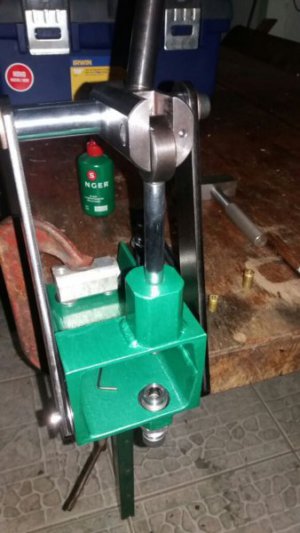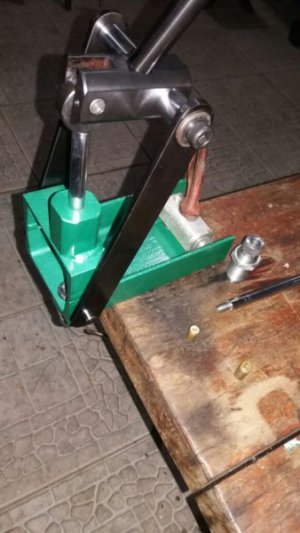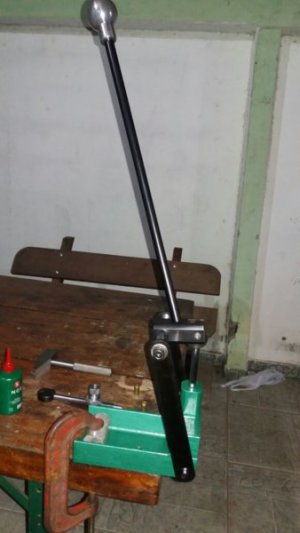-
Welcome back Guest! Did you know you can mentor other members here at H-M? If not, please check out our Relaunch of Hobby Machinist Mentoring Program!
You are using an out of date browser. It may not display this or other websites correctly.
You should upgrade or use an alternative browser.
You should upgrade or use an alternative browser.
Cartridge Calibration Press
- Thread starter TPinheiro
- Start date
Tom,
I use an Hornady Ammo Factory which is a fully automatic press with Auto Case, Primer, Power and Bullet feed. The point I am making is the case on headless ammo is tapered from the head to the bullet end. The dies I use are full length sizing dies that size to that specified taper.
I am trying to understand how a passthrough die can maintain that taper. Are you sizing to the upper end of the taper to take out any head swell in the case?
I know that if I don't maintain that taper the case will either seat too high in the barrel and not chamber or too low and the firing pin will not strike the primer. I use a Reddiing Go No-Go gage to check see that the taper is correct and that the loaded bullet will chamber correctly.
I am firing in Kimber Custom pistols.
I load 380, 9MM Lugar, 40 cal and 45ACP plus al lot of others which are either straight cases with a head like 357 mag and a lots of bottle neck rifle sizes.
Dennis
Dennis,
.380ACP, .40S&W and.45ACP are all straight walled cartridges. Lee sells push through “bulge buster” kits for those and a few more straight walled calibers. They work with the appropriate caliber Lee Carbide FCD (sold separately, as the saying goes). The 9mm Luger is a tapered cartridge, which doesn’t make sense to me for a push through die, but there is a guy on Youtube that uses a 9mm Makarov FCD to push 9mm Luger rounds through. He claims it works, but I can’t say one way or the other. I haven’t seen the need for a push through die myself, but none of my pistols have match chambers nor do I shoot in competition.
I will say the OP’s machine looks hell for stout with lots of leverage to do the job.
Tom
Tom,
I most of my experience is with 9MM Luger which is tapered and for my guns super critical on the proper taper to chamber properly. I have loaded over 20,000. I agree that the 9MM doesn't make sense for the bulge buster because you would only be sizing the larger end of the case which is the head of the case. 45ACP only has a .003 taper which I would agree is close to a straight walled case. Not as critical on getting the taper correct. I have loaded between 5000 and 6000 of them and have only been shooting them over the past two years. I started reloading 45 years ago with the Lee Hand Loader but graduated soon to a turret press and later to an progressive auto press and have not kept up with Lee's offerings other than their cast bullet pass through sizing die's. Lee does make some of the best reloading dies on the market. I like Hornady and RCBS and use them most of the time.
My main question was how this could work on a tapered case and seemed to start a small war. I will take a look at the Lee " Bulge Buster" on their website to get the details.
Thanks,
Dennis
I most of my experience is with 9MM Luger which is tapered and for my guns super critical on the proper taper to chamber properly. I have loaded over 20,000. I agree that the 9MM doesn't make sense for the bulge buster because you would only be sizing the larger end of the case which is the head of the case. 45ACP only has a .003 taper which I would agree is close to a straight walled case. Not as critical on getting the taper correct. I have loaded between 5000 and 6000 of them and have only been shooting them over the past two years. I started reloading 45 years ago with the Lee Hand Loader but graduated soon to a turret press and later to an progressive auto press and have not kept up with Lee's offerings other than their cast bullet pass through sizing die's. Lee does make some of the best reloading dies on the market. I like Hornady and RCBS and use them most of the time.
My main question was how this could work on a tapered case and seemed to start a small war. I will take a look at the Lee " Bulge Buster" on their website to get the details.
Thanks,
Dennis
Dennis,
My apologies, you are correct about .380 and .45 ACP being tapered cartridges, although .45’s taper is only .003” and .380’s taper is a miniscule .0009” on SAAMI drawings, they are in fact tapered as you said. I’ve always heard them referred to as having straight walled cases. I’m obviously running with the wrong crowd. I guess only 9mm is tapered enough to be a problem for push through resizing. In any case, thanks for the education. Just when I thought I couldn't get any smarter...... wrong again.
I guess only 9mm is tapered enough to be a problem for push through resizing. In any case, thanks for the education. Just when I thought I couldn't get any smarter...... wrong again. 
Tom
My apologies, you are correct about .380 and .45 ACP being tapered cartridges, although .45’s taper is only .003” and .380’s taper is a miniscule .0009” on SAAMI drawings, they are in fact tapered as you said. I’ve always heard them referred to as having straight walled cases. I’m obviously running with the wrong crowd.
 I guess only 9mm is tapered enough to be a problem for push through resizing. In any case, thanks for the education. Just when I thought I couldn't get any smarter...... wrong again.
I guess only 9mm is tapered enough to be a problem for push through resizing. In any case, thanks for the education. Just when I thought I couldn't get any smarter...... wrong again. Tom
Not at war with anyone here, just an enthusiast of reloading for many many moons now.
I believe the term straight walled cartridges is a general term used to separate them from bottlenecked cartridges. Both groups of cartridges need to have a slight taper in the body (some are more pronounced) for ease of feeding, chambering and extraction.
Note that the bulge in question here is larger than the big end of the body taper. The way SAAMI specs are made for ammo and chambers, any factory cartridge has to fit in any factory chamber so tolerances are relatively generous. Sometimes the clearance between cartridge and chamber is enough that the body of the case blows out on firing beyond the elastic limit of the brass creating a bulge just above the case head. The head is normally hardened and does not expand unless it receives excessive pressure. Normally this bulge is of no concern when the case is going back into the same chamber. However, after several firings the bulge can be big enough and stiff enough to eventually interfere with smooth chambering. I don't know of any caliber, straight walled or bottlenecked, that is exempt from this potential problem.
Ideally resizing dies should be custom made for the results required so that one die will resize the whole case for a given chamber in one stroke with a minimum of working on the brass. Eventually the brass does work harden from repeated firing and resizing. This work hardened brass does not resize as usual. This situation becomes more critical when faced with the tighter tolerances applied to competitive equipment.
Annealing the brass is one popular solution. But the annealing process which softens the brass back to its original level (hopefully) should only be done at or near the neck. The head end of the case including the bulge must remain hard. The die will then resize the softened brass near the neck properly but the bulge near the head will remain.
A slightly smaller die than the usual full length die must be used to reduce the bulge. The bulge being the widest part (larger diameter) of the whole rimless case, a 'bulge busting' die will squeeze the bulge but will clear the other parts of the case so a push through die is a logical choice for 'calibrating' large quantities.
My experience in bulge busting has been with bottlenecked cases and small base dies. These dies are smaller than the standard f.l. die and squeeze the bulge down to tolerable dimensions. They are not push through dies but they could be if I had the set up for it.
I believe the term straight walled cartridges is a general term used to separate them from bottlenecked cartridges. Both groups of cartridges need to have a slight taper in the body (some are more pronounced) for ease of feeding, chambering and extraction.
Note that the bulge in question here is larger than the big end of the body taper. The way SAAMI specs are made for ammo and chambers, any factory cartridge has to fit in any factory chamber so tolerances are relatively generous. Sometimes the clearance between cartridge and chamber is enough that the body of the case blows out on firing beyond the elastic limit of the brass creating a bulge just above the case head. The head is normally hardened and does not expand unless it receives excessive pressure. Normally this bulge is of no concern when the case is going back into the same chamber. However, after several firings the bulge can be big enough and stiff enough to eventually interfere with smooth chambering. I don't know of any caliber, straight walled or bottlenecked, that is exempt from this potential problem.
Ideally resizing dies should be custom made for the results required so that one die will resize the whole case for a given chamber in one stroke with a minimum of working on the brass. Eventually the brass does work harden from repeated firing and resizing. This work hardened brass does not resize as usual. This situation becomes more critical when faced with the tighter tolerances applied to competitive equipment.
Annealing the brass is one popular solution. But the annealing process which softens the brass back to its original level (hopefully) should only be done at or near the neck. The head end of the case including the bulge must remain hard. The die will then resize the softened brass near the neck properly but the bulge near the head will remain.
A slightly smaller die than the usual full length die must be used to reduce the bulge. The bulge being the widest part (larger diameter) of the whole rimless case, a 'bulge busting' die will squeeze the bulge but will clear the other parts of the case so a push through die is a logical choice for 'calibrating' large quantities.
My experience in bulge busting has been with bottlenecked cases and small base dies. These dies are smaller than the standard f.l. die and squeeze the bulge down to tolerable dimensions. They are not push through dies but they could be if I had the set up for it.
Last edited:




